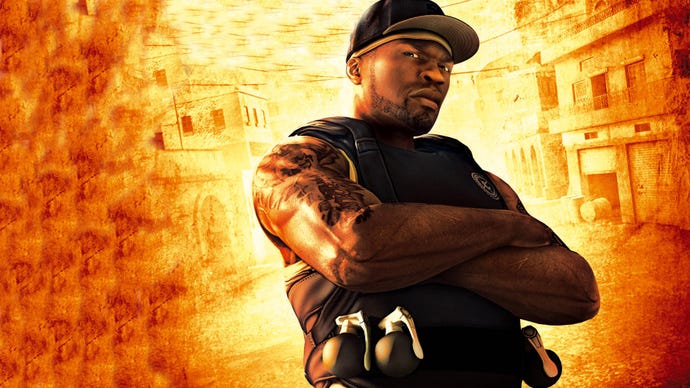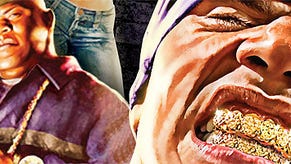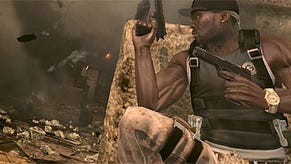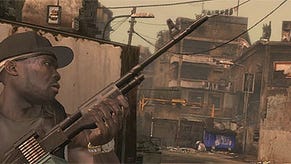On 50 Cent: Blood on the Sand, The Surprisingly Excellent Third-Person Shooter That History Forgot
For 50 Cent: Blood on the Sand's 10th anniversary this year, we give it a long overdue reappraisal.
This article first appeared on USgamer, a partner publication of VG247. Some content, such as this article, has been migrated to VG247 for posterity after USgamer's closure - but it has not been edited or further vetted by the VG247 team.
Not too long ago, I found myself going back through some of the older triple-A games I'd missed. These games hadn't reviewed too well—most were short or in an unpopular series—and I've been having a surprisingly great time. Not too long ago, I picked up 50 Cent: Blood on the Sand, and I fell in love with it.
I passed over Blood on the Sand back in 2009 because spending $60 on the most seventh-generation game ever—a brown and grey cover shooter that served as a vehicle for a rapper to gun down people in an unnamed Middle Eastern country—seemed like the least appealing thing in the world. I wasn't the only one. After a few months on the market, Blood on the Sand had only sold around 56,000 copies. Like so many games of that generation, Blood on the Sand seemed like it would be better off forgotten.
The idea was so absurd, so outrageous, so absolutely unimportant that it's easy to see why people would rather laud big triple-A games about sad dads with tragic pasts who shepherd their children through strange and fantastical worlds and enact considerable violence in the process. Who wants to play a game about a celebrity's ego trip through a very real war-torn space? How could that be important or interesting or meaningful or worth the steep $60 price of admission?
But I'm a sucker.
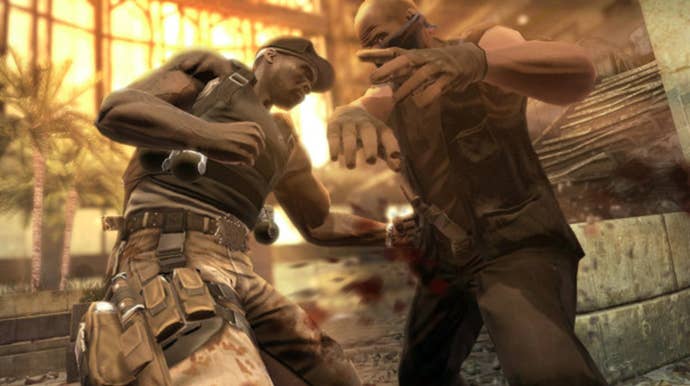
I'm a sucker for the bad and broken games, the ones that didn't make it. Sure, some of them are just plain bad and not worth your time or attention. The last generation was littered with games like that. Legendary, Turning Point: Fall of Liberty, and Darkest of Days are some of the worst games I've ever played. Maybe they don’t play well, their stories aren't interesting, the features aren’t that surprising, but hey, that was also true of some of the last gen’s biggest releases, like Killzone 2.
Because it was true for some of last gen's biggest games, that means the opposite is true too. Sometimes, the forgotten games play the best. Maybe they came out at the wrong time, or they were so short it was hard to justify the $60 price tag. I've been head over heels for Lost Planet 2 recently, but so many people pushed back against it because it wasn't like the first and it was built to be a co-op only game. In a world today that embraces games like Destiny and The Division, maybe it would have been a bigger success. Games need word of mouth to succeed, and sometimes, bad word of mouth stops great games in their tracks.
I'm a sucker for the forgotten games because sometimes I find something miraculous. I find a game that has heart, that tries interesting mechanics, that teaches me something interesting about video games. Sometimes I find a game like 50 Cent: Blood on the Sand, a surprisingly sharp, well-built game that I think deserves a reevaluation.
A Dumb But Earnest Vibe
Curtis James Jackson III, better known as 50 Cent, Fiddy or Fift to his friends, and Mr. Cent to his enemies, is performing in a war-torn Middle Eastern country. Anwar, his concert promoter, reveals that he can’t pay 50 Cent his $10 million fee, which prompts our rapper to demand payment or blood. Anwar offers a jewel-encrusted crystal skull instead, which 50 Cent begrudgingly accepts. A mysterious woman steals it, which sets off an impossible chain of events in which 50 Cent and another member from his crew G-Unit (I chose Lloyd Banks because he was referenced in "In Da Club," so he seemed cool), chase the skull and slaughter hundreds of bad guys in the process. This is a stupid premise, but there’s something refreshingly earnest about it.
At one point after a gunfight, 50 Cent laments that he can't "kick it with some hoes," which is what he'd rather be doing right now. Blood on the Sand wants you to relax and have fun. It's a game where 50 Cent might say something about these ruins being ancient, and Banks replies back with "Napoleonic, I presume," to which Fiddy laughs incredulously. There's a charm here, a sort of warmth and joy and sincerity to the whole thing that I find compelling.
Blood on the Sand doesn't bother trying to justify itself. There's no feigned sincerity, no desire to say something bigger about the world, no unwarranted self-importance. Blood on the Sand is a game about self-care. It's a game that wants you to be happy and have a good time. It's a game by the guy who started his most famous song with "it's your birthday" because "every day it's relevant all over 'cause every day is someone's birthday." So you blast your way through hordes of terrorists while their leader shouts things like "Fifty Cent, your skull is mine, and soon, your life will be mine also!" and you have a great time doing it, because that’s what Blood on the Sand is here for.
Great game design isn't just about making something fun, it's about ensuring that it doesn't overstay its welcome, and Blood on the Sand is surprisingly great at this. Linear games are generally built on an alternating pattern of arenas and hallways, and the key to making these encounters feel good has always been to ensure that no encounter ever repeats. You might find yourself rushing through a courtyard, taking sniper fire from above, only to enter a corridor on the far side, head upstairs, and find your roles reversed, lobbing grenades down at enemies who just arrived the way you came.
It's not a perfect game by any means—Blood on the Sand's development was tumultuous, not just because it changed publishers (from Activision to THQ), but because 50 Cent’s at the time 7-year-old son had a hand in its development. According to an interview in Edge Magazine, Marquise Jackson demanded that the game feature helicopters. The developers didn’t think that was possible, but 50 Cent insisted that his son’s instructions be followed, so they made it work.
What struck me about this anecdote was how one of the developers suggested that the helicopters and car chases 50 Cent insisted on weren't crucial to the game as a third-person shooter. One of the reasons Blood on the Sand works so well is because it changes things up. While the attention given to the third-person sections is wonderful, the change of pace provided by the vehicle sections elevates it further.
Of course, reviews slammed the game for having five helicopter boss fights, and I can certainly see why: it's never fun to use the same mechanics in the same way on the same boss five different times throughout the course of a campaign. On a macro level, Blood on the Sand is unexpectedly thrilling and refreshingly unpretentious, but for me, where it really shines is the moment to moment gameplay. There's a taunt button that lets you swear at your enemies. It's got "Gangsta Fire," which is 50 Cent's version of bullet time where you build it up by performing melee kills on enemies with well-timed presses of the B button.
Blood on the Sand breaks up its weapons into three categories. You've got grey pistols with infinite ammo, blue short range weapons, yellow rifles, and red heavy weapons, which you can loot from enemies or purchase at portable phones around the world. Enemies wear corresponding colors, so you know that guys in red can hit you hard, guys in blue want to flank you and get in close, while guys in yellow tend to prefer taking cover and hitting you from range.
This primary color system extends itself to ammunition in the world, with red, blue, and yellow ammo boxes that can be found throughout the world, giving you incentive to explore. This clearly-delineated ammo system doesn't just make combat easier to parse, it also helps you plan. It's something that some of this generation's best games, like Destiny and the recent Apex Legends, both do. Through most of the seventh generation, shooters tended to ensure players never ran out of ammo, like in Call of Duty, where it's easy to find one of a dozen different assault rifles that all play the same. In most seventh-gen games, you're never saying "okay, I need ammunition for this gun, where is it, and how do I get to it?"
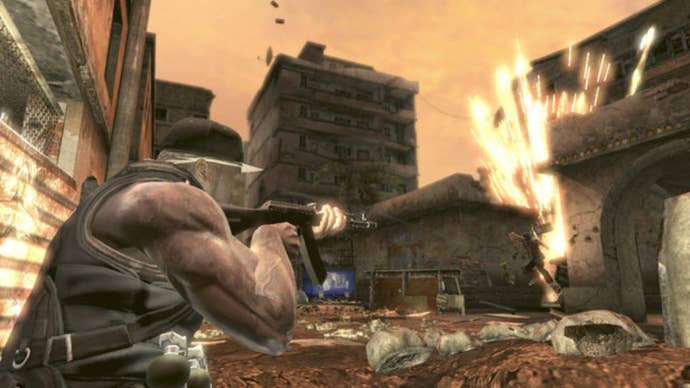
Blood on the Sand's level design isn’t just varied, it's also extremely good at showing you something you can't get to right away. This means you start asking questions and establishing goals for yourself. See that red ammo crate? That would pair really nicely with your rocket launcher. This kind of short term, small-scale sense of player-motivated planning means that you're always setting and accomplishing small goals for yourself, which feels a lot more rewarding than, say, a game which automatically spawns whatever ammo you happen to need at that moment in time. Great combat offers clarity and encourages planning, and the primary color system accomplishes both of those goals.
On top of that, Blood on the Sand has an arcade style score system that encourages you to chain kills together for combos, raising your overall score. If you don't get a gold medal the first time, you can always try again, and the medals aren't easy to earn. Getting combos adds energy to your Gangster Time meter, which means you can run into a room, watch a missile blast past you in slow motion, then shotgun an enemy in the head on your way to recovering your crystal skull.
Kills give you cash, which you can use to buy new and better weapons, but money disappears pretty quickly, so you’re not just shooting everyone you can, you’re shooting them and trying to figure out how to get to the cash before it disappears. Once again, the game’s encouraging you to make short-term plans that feel satisfying when you execute them. It's a constant stream of dopamine release, giving you optional obstacles and rewards and making you feel good when you surpass them.
It's a fun, tough game, but the cherry on top is its challenge system.
Sometimes, when you walk into the room, the game introduces a challenge. Maybe you need to kill all reinforcements in 40 seconds or find and shoot the snipers in 10. For challenges about killing enemies, the game will helpfully highlight them in red so you know who you need to target and where they are. It adds a delicious sense of texture to the encounters. You never lose anything if you fail, but winning nets you points and explosives.
Plenty of games feature grenades and molotovs, but Blood on the Sand’s are among my favorites in a video game. As best I can tell, they don’t have auto-aim, but if you accidentally throw too far, the game will generously stop them on their way and detonate them. Unlike other games, with grenades that take ages to detonate or tend to be weak, making it easier for enemies to avoid or survive them, Blood on the Sand’s grenades guarantee a one-hit kill. Completing challenges gets you explosives. Explosives make it easier to get kills and complete more challenges… which makes it easier to get more explosives, and so on.. It's a positive feedback loop.
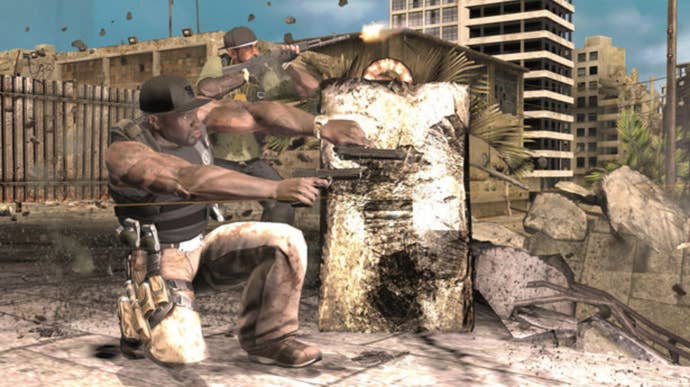
All of this, when bundled together, creates a game that's way more fun than its premise may suggest. It's an endlessly positive game. Instead of trash talking you when you die, Blood on the Sand doesn't seem to mind. It's a game that goes "Hey, that’s okay, try again. No reason to get punished for doing bad, you'll get it next time!"
Blood on the Sand is a game that just wants you to have a good time. It’s encouraging and positive without ever feeling like an ego trip. It’s a game that makes me happy, though it certainly isn’t the game I expected from Swordfish Studios, the developer of games like Cold Winter and Brian Lara International Cricket 2005.
Blood on the Sand's Downfall
So why did Blood on the Sand fall flat on its face? Maybe it’s because the last game in the series, the PlayStation 2 and Xbox action game Bulletproof, was so bad that most people didn’t think there could be a good 50 Cent game. Maybe it’s because Uncharted 2 was about to come out and looked way more colorful than a game that typified the brown and grey style typical of the seventh generation. Personally, I think it’s because the premise seemed ludicrous: a real celebrity, playing himself, shoots people like a terrible action hero in an unnamed Middle Eastern country for some reason. It felt like every game was trying to copy Call of Duty.
Blood on the Sand didn’t seem justified.
Fast-forward to today, and Crackdown 3 has released to mixed reviews. Personally, I think it's super fun and really smartly designed. It’s a game that deserves your time and attention. But, if you look at the critical and fan response, not many people are taking Crackdown 3 seriously. I’ve seen a lot of bizarre comparisons to big, self-serious triple-A experiences, wherein Crackdown 3 always comes up lacking because it's a silly superhero cartoon action game.
After I discussed Crackdown 3 publicly on Twitter, one person told me that Crackdown “didn’t deserve to exist,” but was quick to bring up God of War and suggest that it did. Another complained about the graphics, saying it reminded him of an indie game, and brought up The Last of Us, suggesting Crackdown 3 didn’t look as good. Several people had similar responses, listing a bunch of serious, dramatic third-person action-adventure games and suggesting that Crackdown 3 wasn’t worth playing. As best I could tell, none of them had played the game—several straight up said as much—they passed judgment based on trailers and other pre-release footage, and decided it wasn’t worthwhile for them to even consider.
That bums me out.
Our reception of a game is based so much on perception. How important the game is, what topics the game covers. Often, mechanics aren't enough. Features aren’t enough. The perception is what really matters. If the game feels important, it will be important. If it doesn't, players will discard it.
50 Cent: Blood in the Sand doesn't offer a fantasy people really wanted to play. It's easy to look at this game that seems like a weird, tone-deaf power fantasy, and go "yeah, that sounds stupid. Why play it?" Because of this, so many people overlooked a genuinely fun game, and that's frustrating, but it's also understandable. When games cost $60, it's hard to justify buying everything, even if it looks interesting. It's easy to filter out the games that seem like they won't matter and focus on sequels in series we like or games from developers and publishers who've earned our trust. A weird game about a rapper shooting people in the Middle East was never going to sell, no matter how good its mechanics were.
50 Cent: Blood on the Sand was not a successful game. Swordfish Studios shut down the next year. Its developers scattered to the winds, some of its employees later working on games like Bioshock Infinite and Bulletstorm. And that's too bad, because despite its ungainly presentation, 50 Cent: Blood on the Sand is a wonderful experience.
